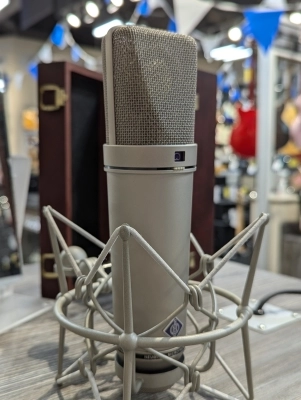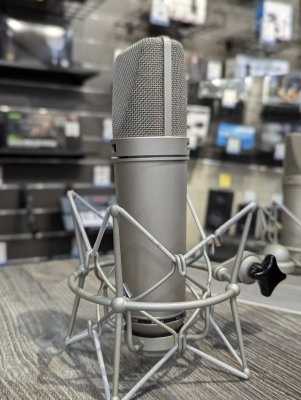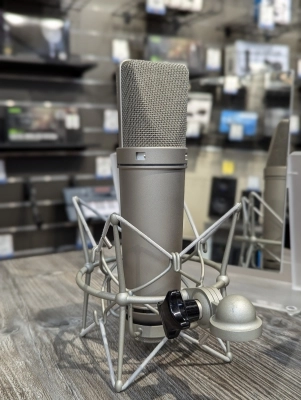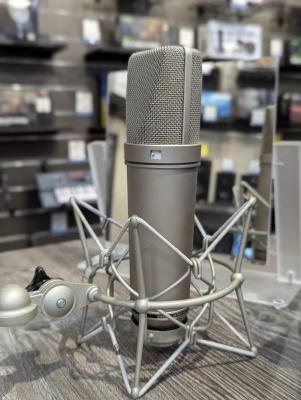Gear Hunter
Neumann - U 87 AI SET




Sale Price: $4925
Buy From Store
Customer responsible for any shipping charges.
Description
The Neumann U 87 Ai is probably the best-known and most frequently used studio microphone the world over. Its smooth and refined sound is as iconic as its elegant exterior design. The U 87 Ai is the standard microphone for speech and vocals. Three polar patterns plus pad and low cut options make it adaptable to a wide range of applications.
* Balanced frequency response in three polar patterns
* Very low self-noise
* Classic sound
The U 87 Ai is the epitome of a large diaphragm condenser microphone. Its tapered body and iconic headgrille design have become part of the collective consciousness: This is what a studio microphone looks like. The same is true of its sound: The U 87 Ai represents studio quality; it has become the gold standard by which other microphones are measured.
What sets the U 87 Ai apart is its unique combination of linearity and character. Although its on-axis frequency response is remarkably flat, it does exert certain charisma. It just sounds right! This makes the U 87 Ai both versatile and instantly recognizable.
Applications
The U 87 Ai condenser microphone is a large diaphragm microphone with three polar patterns and a unique frequency and transient response characteristic. It is a good choice for most general purpose applications in studios, for broadcasting, film and television. The U 87 Ai is used as a main microphone for orchestra recordings, as a spot mic for single instruments, and extensively as a vocal microphone for all types of music and speech.
Acoustic features
The U 87 Ai is addressed from the front, marked with the Neumann logo. The frequency response of the cardioid and figure-8 directional characteristics are very flat for frontal sound incidence, even in the upper frequency range. The microphone can be used very close to a sound source without the sound becoming unnaturally harsh. By means of a high-pass filter interferences through subsonic and low frequencies are reduced remarkably.
Polar patterns
The dual-diaphragm capsule is elastically mounted and protected by a large headgrille. A switch below the headgrille selects the three directional patterns: omnidirectional, cardioid and figure-8. A window above this switch shows the symbol of the selected characteristic.
Electrical features
The letter A in the name indicates a more recent generation, as compared to the U 87 i microphones that were built from 1967 to 1986. Modifications apply to the electronic components of the microphone only; the capsule remained unchanged.
The present-day circuitry increases the operational headroom of the U 87 Ai by supplying the bias voltages for the capsule through a reduced resistance. The result is a higher sensitivity of 10 dB for identical sound pressure levels, and an improved S/N ratio of 3 dB.
Filter and attenuation
A switch located at the rear attenuates the sensitivity by 10 dB. When this switch is activated, the microphone accepts sound pressure levels up to 127 dB (equivalent to a sound pressure of 45 Pa) without distortion.
An additional switch at the rear allows to change the microphone's cutoff frequency. This reduces low frequency interference directly at the input of the microphone amplifier.
This setting also compensates for the unavoidable bass boost that occurs with all pressure gradient transducers when they are used at close distance (proximity effect).
The cardioid characteristic maintains a smooth frequency response at a distance of 30 to 40 cm, the figure-8 characteristic even at a distance of 15 to 20 cm.
Features
* Variable large diaphragm microphone
* Pressure-gradient transducer with double membrane capsule
* The studio microphone classic
* Three directional characteristics: omni, cardioid, figure-8
* Switchable low frequency roll-off
* Switchable 10 dB pre-attenuation
* Ideal as main and as support microphone in the most differing recording situations
Specifications
Acoustical operating principle: Pressure gradient transducer
Directional pattern: Omnidirectional, cardioid, figure-8
Frequency range: 20 Hz - 20 kHz
Sensitivity at 1 kHz into 1 kohm: 20/28/22 mV/Pa1)
Rated impedance: 200 ohms
Rated load impedance: 1 kohms
Equivalent noise level, CCIR): 26/23/25 dB1)
Equivalent noise level, A-weighted): 15/12/14 dB-A1)
Signal-to-noise ratio, CCIR) (rel. 94 dB SPL): 68/71/69 dB1)
Signal-to-noise ratio, A-weighted) (rel. 94 dB SPL): 79/82/80 dB1)
Maximum SPL for THD 0.5%3): 117 dB (cardioid)
Maximum SPL for THD 0.5% with preattenuation3): 127 dB
Maximum output voltage: 390 mV
Supply voltage (P48, IEC 61938): 48 V 4 V
Current consumption (P48, IEC 61938): 0.8 mA
Matching connectors: XLR3F
Weight: 500 g
Diameter: 56 mm
Length: 200 mm


